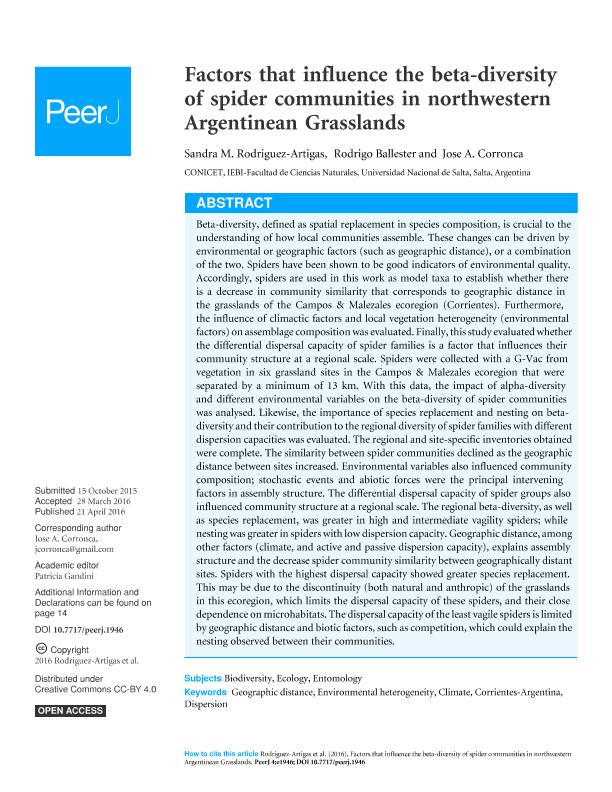Mostrar el registro sencillo del ítem
dc.contributor.author
Rodriguez Artigas, Sandra Mónica

dc.contributor.author
Ballester, Rodrigo

dc.contributor.author
Corronca, Jose Antonio

dc.date.available
2021-03-25T20:26:58Z
dc.date.issued
2016-04-21
dc.identifier.citation
Rodriguez Artigas, Sandra Mónica; Ballester, Rodrigo; Corronca, Jose Antonio; Factors that influence the beta-diversity of spider communities in northwestern Argentinean Grasslands; PeerJ Inc.; PeerJ; 2016; 4; 21-4-2016; 1-19
dc.identifier.issn
2167-8359
dc.identifier.uri
http://hdl.handle.net/11336/128973
dc.description.abstract
Beta-diversity, defined as spatial replacement in species composition, is crucial to the understanding of how local communities assemble. These changes can be driven by environmental or geographic factors (such as geographic distance), or a combination of the two. Spiders have been shown to be good indicators of environmental quality. Accordingly, spiders are used in this work as model taxa to establish whether there is a decrease in community similarity that corresponds to geographic distance in the grasslands of the Campos & Malezales ecoregion (Corrientes). Furthermore, the influence of climactic factors and local vegetation heterogeneity (environmental factors) on assemblage composition was evaluated. Finally, this study evaluated whether the differential dispersal capacity of spider families is a factor that influences their community structure at a regional scale. Spiders were collected with a G-Vac from vegetation in six grassland sites in the Campos & Malezales ecoregion that were separated by a minimum of 13 km. With this data, the impact of alpha-diversity and different environmental variables on the beta-diversity of spider communities was analysed. Likewise, the importance of species replacement and nesting on betadiversity and their contribution to the regional diversity of spider families with different dispersion capacities was evaluated. The regional and site-specific inventories obtained were complete. The similarity between spider communities declined as the geographic distance between sites increased. Environmental variables also influenced community composition; stochastic events and abiotic forces were the principal intervening factors in assembly structure. The differential dispersal capacity of spider groups also influenced community structure at a regional scale. The regional beta-diversity, as well as species replacement, was greater in high and intermediate vagility spiders; while nesting was greater in spiders with low dispersion capacity. Geographic distance, among other factors (climate, and active and passive dispersion capacity), explains assembly structure and the decrease spider community similarity between geographically distant sites. Spiders with the highest dispersal capacity showed greater species replacement. This may be due to the discontinuity (both natural and anthropic) of the grasslands in this ecoregion, which limits the dispersal capacity of these spiders, and their close dependence on microhabitats. The dispersal capacity of the least vagile spiders is limited by geographic distance and biotic factors, such as competition, which could explain the nesting observed between their communities.
dc.format
application/pdf
dc.language.iso
eng
dc.publisher
PeerJ Inc.
dc.rights
info:eu-repo/semantics/openAccess
dc.rights.uri
https://creativecommons.org/licenses/by/2.5/ar/
dc.subject
CLIMATE
dc.subject
CORRIENTES-ARGENTINA
dc.subject
DISPERSION
dc.subject
ENVIRONMENTAL HETEROGENEITY
dc.subject
GEOGRAPHIC DISTANCE
dc.subject.classification
Ecología

dc.subject.classification
Ciencias Biológicas

dc.subject.classification
CIENCIAS NATURALES Y EXACTAS

dc.title
Factors that influence the beta-diversity of spider communities in northwestern Argentinean Grasslands
dc.type
info:eu-repo/semantics/article
dc.type
info:ar-repo/semantics/artículo
dc.type
info:eu-repo/semantics/publishedVersion
dc.date.updated
2021-03-25T13:51:39Z
dc.identifier.eissn
2376-5992
dc.journal.volume
2016
dc.journal.number
4
dc.journal.pagination
1-19
dc.journal.pais
Estados Unidos

dc.description.fil
Fil: Rodriguez Artigas, Sandra Mónica. Universidad Nacional de Salta. Facultad de Ciencias Naturales. Instituto para el Estudio de la Biodiversidad de Invertebrados; Argentina. Consejo Nacional de Investigaciones Científicas y Técnicas. Centro Científico Tecnológico Conicet - Salta; Argentina
dc.description.fil
Fil: Ballester, Rodrigo. Universidad Nacional de Salta. Facultad de Ciencias Naturales. Instituto para el Estudio de la Biodiversidad de Invertebrados; Argentina. Consejo Nacional de Investigaciones Científicas y Técnicas. Centro Científico Tecnológico Conicet - Salta; Argentina
dc.description.fil
Fil: Corronca, Jose Antonio. Universidad Nacional de Salta. Facultad de Ciencias Naturales. Instituto para el Estudio de la Biodiversidad de Invertebrados; Argentina. Consejo Nacional de Investigaciones Científicas y Técnicas. Centro Científico Tecnológico Conicet - Salta; Argentina
dc.journal.title
PeerJ
dc.relation.alternativeid
info:eu-repo/semantics/altIdentifier/doi/http://dx.doi.org/10.7717/peerj.1946
dc.relation.alternativeid
info:eu-repo/semantics/altIdentifier/url/https://peerj.com/articles/1946/
Archivos asociados
